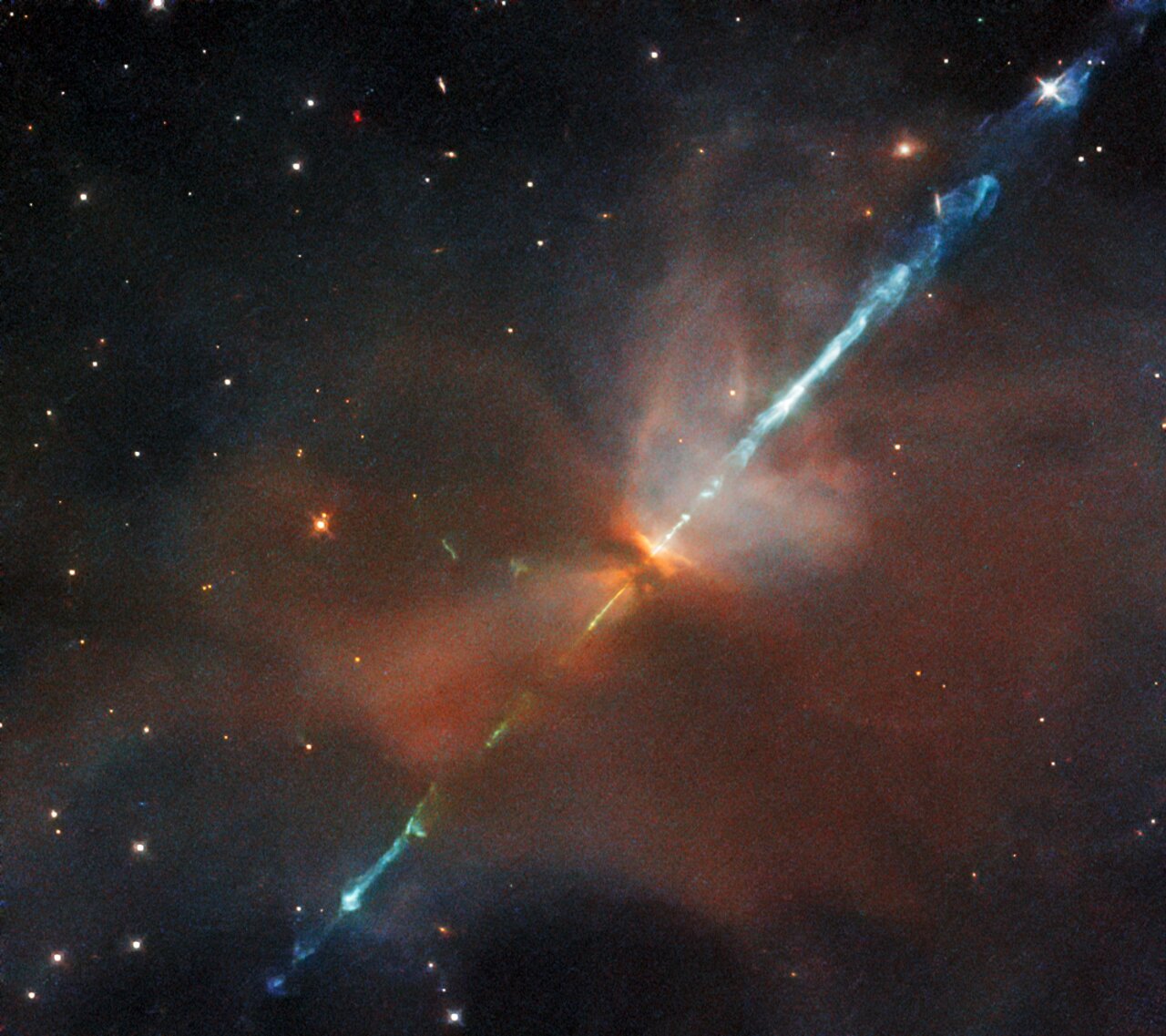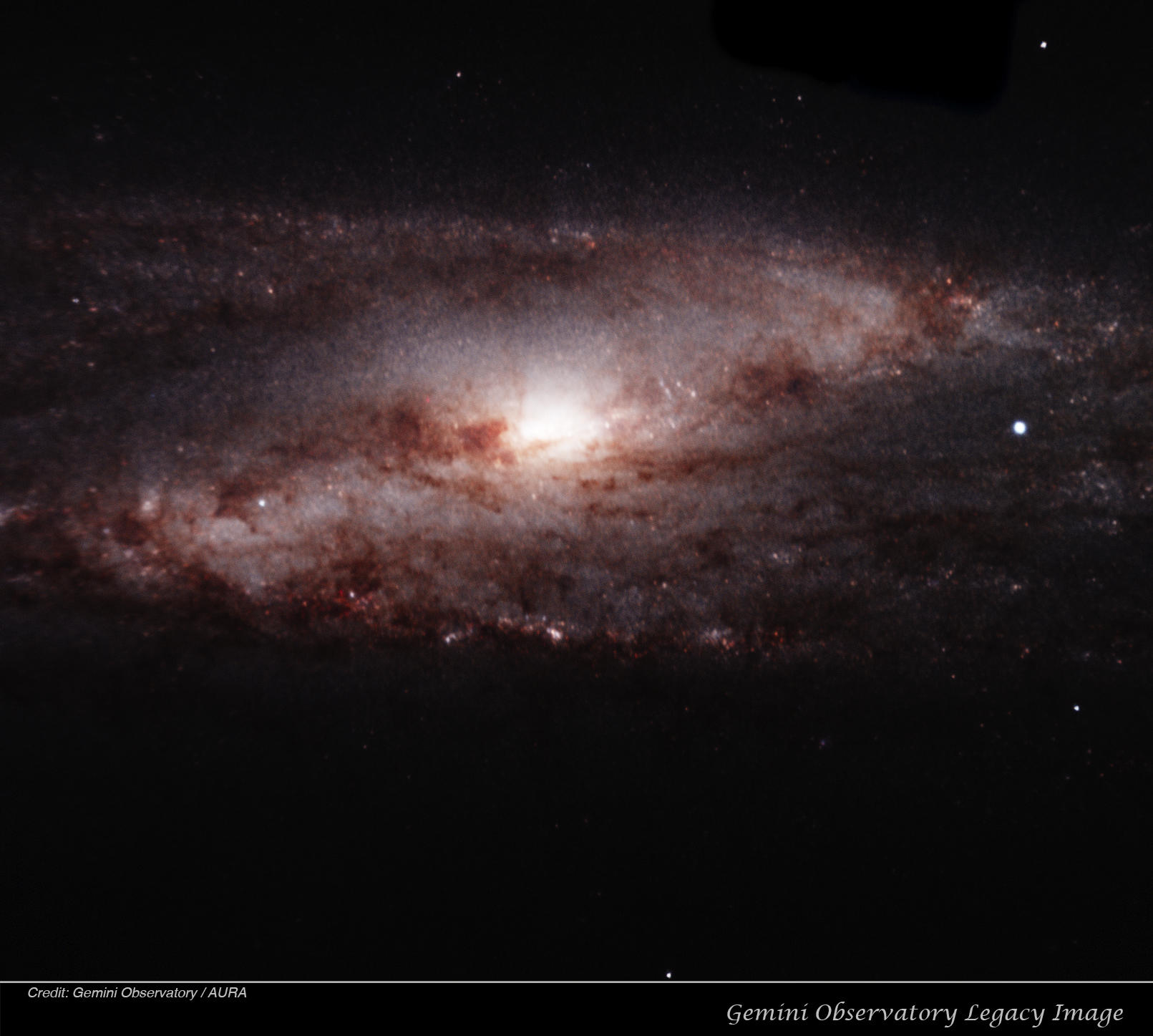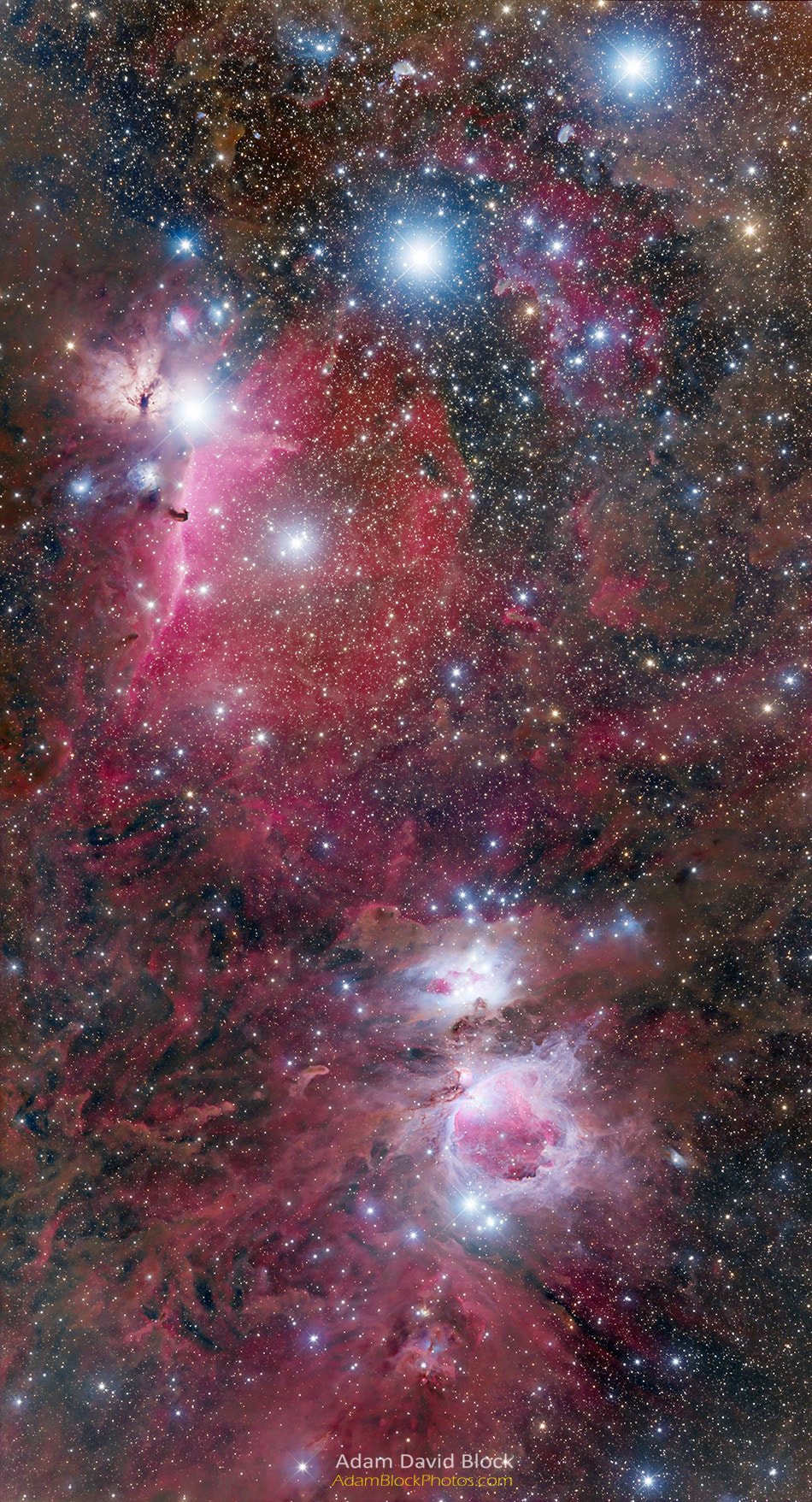Blog
This striking image features a relatively rare celestial phenomenon known as a Herbig–Haro object. This particular Herbig–Haro object is named HH111, and was imaged by Hubble’s Wide Field Camera 3 (WFC3). These spectacular objects are formed under very specific circumstances. Newly formed stars are often very active, and in some cases they expel very narrow jets of rapidly moving ionised gas — gas that is so hot that its molecules and atoms have lost their electrons, making the gas highly charged. The streams of ionised gas then collide with the clouds of gas and dust surrounding newly-formed stars at speeds of hundreds of kilometres per second. It is these energetic collisions that create Herbig–Haro objects such as HH111. WFC3 takes images at optical and infrared wavelengths, which means that it observes objects at a wavelength range similar to the range that human eyes are sensitive to (optical) and a range of wavelengths that are slightly too long to be detected by human eyes (infrared). Herbig–Haro objects actually release a lot of light at optical wavelengths, but they are difficult to observe because their surrounding dust and gas absorb much of the visible light. Therefore, the WFC3’s ability to observe at infrared wavelengths — where observations are not as affected by gas and dust— is crucial to observing Herbo–Haro objects successfully.

Robert Dennis Crumb (/krʌm/; born August 30, 1943) is an American cartoonist and musician who often signs his work R. Crumb. His work displays a nostalgia for American folk culture of the late 19th and early 20th centuries, and satire of contemporary American culture.
Crumb is a prolific artist and contributed to many of the seminal works of the underground comix movement in the 1960s, including being a founder of the first successful underground comix publication, Zap Comix, contributing to all 16 issues. He was additionally contributing to the East Village Otherand many other publications, including a variety of one-off and anthology comics. During this time, inspired by psychedelics and cartoons from the 1920s and 1930s, he introduced a wide variety of characters that became extremely popular, including countercultural icons Fritz the Cat and Mr. Natural, and the images from his Keep On Truckin’ strip. Sexual themes abounded in all these projects, often shading into scatological and pornographic comics. In the mid-1970s, he contributed to the Arcade anthology; following the decline of the underground, he moved towards biographical and autobiographical subjects while refining his drawing style, a heavily crosshatched pen-and-ink style inspired by late 19th- and early 20th-century cartooning. Much of his work appeared in a magazine he founded, Weirdo (1981–1993), which was one of the most prominent publications of the alternative comics era. As his career progressed, his comic work became more autobiographical.
In 1991, Crumb was inducted into the comic book industry’s Will Eisner Comic Book Hall of Fame. He is married to cartoonist Aline Kominsky-Crumb, with whom he has frequently collaborated. Their daughter Sophie Crumb has also followed a cartooning career.
more...McKinley Howard “Kenny” Dorham (August 30, 1924 – December 5, 1972) was an American jazz trumpeter, singer, and composer. Dorham’s talent is frequently lauded by critics and other musicians, but he never received the kind of attention or public recognition from the jazz establishment that many of his peers did. For this reason, writer Gary Giddins said that Dorham’s name has become “virtually synonymous with underrated.”Dorham composed the jazz standard “Blue Bossa“, which first appeared on Joe Henderson‘s album Page One.
Dorham was one of the most active bebop trumpeters. He played in the big bands of Lionel Hampton, Billy Eckstine, Dizzy Gillespie, and Mercer Ellington and the quintet of Charlie Parker. He joined Parker’s band in December 1948. He was a charter member of the original cooperative Jazz Messengers. He also recorded as a sideman with Thelonious Monk and Sonny Rollins, and he replaced Clifford Brown in the Max RoachQuintet after Brown’s death in 1956. In addition to sideman work, Dorham led his own groups, including the Jazz Prophets (formed shortly after Art Blakey took over the Jazz Messengers name). The Jazz Prophets, featuring a young Bobby Timmons on piano, bassist Sam Jones, and tenorman J. R. Monterose, with guest Kenny Burrell on guitar, recorded a live album ‘Round About Midnight at the Cafe Bohemia in 1956 for Blue Note.
In 1963, Dorham added the 26-year-old tenor saxophonist Joe Henderson to his group, which later recorded Una Mas (the group also featured a young Tony Williams). The friendship between the two musicians led to a number of other albums, such as Henderson’s Page One, Our Thing and In ‘n Out. Dorham recorded frequently throughout the 1960s for Blue Note and Prestige Records, as leader and as sideman for Henderson, Jackie McLean, Cedar Walton, Andrew Hill, Milt Jackson and others. During his final years Dorham suffered from kidney disease, from which he died on December 5, 1972, aged 48.
more...William Stevens Bryant (August 30, 1908 – February 9, 1964) was an American jazz bandleader, vocalist, and disc jockey, known as the “Mayor of Harlem”.
Born in Chicago, Illinois, United States, while growing up he took trumpet lessons to little success. His first job in entertainment was dancing in the Whitman Sisters Show in 1926. He worked in various vaudeville productions for the next several years, and in 1934 he appeared in the show Chocolate Revue with Bessie Smith.
In 1934, he put together his first big band, which at times included Teddy Wilson, Cozy Cole, Johnny Russell, Benny Carter, Ben Webster, Eddie Durham, Ram Ramirez, and Taft Jordan. They recorded six times between 1935 and 1938; Bryant sings on 18 of the 26 sides recorded.
Once his ensemble disbanded, Bryant worked in acting and disc jockeying. He recorded R&B in 1945 and led another big band between 1946 and 1948. During September and October 1949, he hosted Uptown Jubilee, a short-lived all-black variety show on CBS-TV . The show aired on Tuesday nights. In the 1950s he was the emcee at the Apollo Theater in Harlem. He died of a heart attack in Los Angeles, California on February 9, 1964.
more...Pioneering reggae and dub vocalist and producer Lee “Scratch” Perry died on August 29, 2021 in Jamaica. Rainford Hugh Perry, better known as Lee “Scratch” Perry, was born March 20, 1936 in Kendal, Jamaica. Lee “Scratch” Perry was one of Jamaica’s most famous producers, who collaborated extensively with his friend Bob Marley. Perry produced many of Marley’s songs during the essential period in the early 1970s when reggae emerged as a new genre, resulting in classics such as “Soul Rebel,” “Duppy Conqueror, “Sun In Shining” and the later “Smile Jamaica” and “Punky Reggae Party.”
more...In this near-infrared image, FLAMINGOS-2 peered deep into the heart of spiral galaxy NGC 253, which lies about 11.5 million light-years nearby in the constellation of Sculptor. The new instrument captured an intricate whirlpool of dust spiraling in to a diffuse nuclear region, where violent star formation may be occurring around a supermassive black hole. The instrument also imaged a dusting of star forming sites in its spiral arms.

Michael Joseph Jackson (August 29, 1958 – June 25, 2009 Gary, IN) was an American singer, songwriter, and dancer. Dubbed the “King of Pop“, he is regarded as one of the most significant cultural figures of the 20th century. Over a four-decade career, his contributions to music, dance and fashion, along with his publicized personal life, made him a global figure in popular culture. He influenced artists across many genres, and through stage and video performances, popularized complicated dance moves such as the moonwalk, to which he gave the name, and the robot. He is the most awarded music artist in history.
The eighth child of the Jackson family, Jackson made his professional debut in 1964 with his elder brothers Jackie, Tito, Jermaine, and Marlon as a member of the Jackson 5. Jackson began his solo career in 1971 while at Motown Records, and became a solo star with his 1979 album Off the Wall. His music videos, including those for “Beat It“, “Billie Jean“, and “Thriller” from his 1982 album Thriller, are credited with breaking racial barriers and transforming the medium into an art form and promotional tool. He helped propel the success of MTV and continued to innovate with videos on the albums Bad (1987), Dangerous (1991), and HIStory: Past, Present and Future, Book I (1995). Thriller became the best-selling album of all time, while Bad was the first album to produce five US Billboard Hot 100 number-one singles with “I Just Can’t Stop Loving You“, “Bad“, “The Way You Make Me Feel“, “Man in the Mirror“, and “Dirty Diana“.
From the late 1980s, Jackson became a figure of controversy and speculation due to his changing appearance, relationships, behavior and lifestyle. In 1993, he was accused of sexually abusing the child of a family friend. The lawsuit was settled out of civil court, and Jackson was not indicted due to lack of evidence. In 2005, he was tried and acquitted of further child sexual abuse allegations and several other charges. In 2009, while preparing for a series of comeback concerts, This Is It, Jackson died from an overdose of propofol administered by his personal physician, Conrad Murray, who was subsequently convicted of involuntary manslaughter.
Jackson is one of the best-selling music artists of all time, with estimated sales of over 400 million records worldwide. He had 13 Billboard Hot 100 number-one singles, more than any other male artist in the Hot 100 era, and was the first artist to have a top-ten single in the Billboard Hot 100 in five different decades. His honors include 15 Grammy Awards, a Juno Award, six Brit Awards, a Golden Globe Award, and 39 Guinness World Records, including the “Most Successful Entertainer of All Time”. Jackson’s inductions include the Rock and Roll Hall of Fame twice, the Vocal Group Hall of Fame, the Songwriters Hall of Fame, the Dance Hall of Fame (the only recording artist to be inducted), the Black Music and Entertainment Walk of Fame and the Rhythm and Blues Music Hall of Fame. In 2016, his estate earned $825 million, the highest yearly amount for a celebrity ever recorded by Forbes. On June 25, 2009, less than three weeks before the first This Is It show was due to begin in London, with all concerts sold out, Jackson died from cardiac arrest.Conrad Murray, his personal physician, had given Jackson various medications to help him sleep at his rented mansion in Holmby Hills, Los Angeles. Paramedics received a 911 call at 12:22 pm Pacific time (19:22 UTC), and arrived three minutes later. Jackson was not breathing and CPR was performed.
more...Bennie Maupin (born August 29, 1940, Detroit, Michigan) is a jazz multireedist who performs on various saxophones, flute, and bass clarinet.
He is known for his participation in Herbie Hancock‘s Mwandishi sextet and Headhunters band, and for performing on Miles Davis‘s seminal fusionrecord, Bitches Brew. Maupin has collaborated with Horace Silver, Roy Haynes, Woody Shaw, Lee Morgan and many others. He is noted for having a harmonically-advanced, “out” improvisation style, while having a different sense of melodic direction than other “out” jazz musicians such as Eric Dolphy.
Maupin was a member of Almanac, a group with Cecil McBee (bass), Mike Nock (piano) and Eddie Marshall (drums).
https://www.youtube.com/watch?v=KKGBLjjy-hQ
more...Dinah Washington (born Ruth Lee Jones; August 29, 1924 – December 14, 1963) was an American singer and pianist, who has been cited as “the most popular black female recording artist of the 1950s songs”. Primarily a jazz vocalist, she performed and recorded in a wide variety of styles including blues, R&B, and traditional pop music, and gave herself the title of “Queen of the Blues”. She was a 1986 inductee of the Alabama Jazz Hall of Fame, and was inducted into the Rock and Roll Hall of Fame in 1993.
Ruth Lee Jones was born in Tuscaloosa, Alabama, to Alice and Ollie Jones, and moved to Chicago as a child. She became deeply involved in gospel music and played piano for the choir in St. Luke’s Baptist Church while still in elementary school. She sang gospel music in church and played piano, directing her church choir in her teens and was a member of the Sallie Martin Gospel Singers. When she joined the Sallie Martin group, she dropped out of Wendell Phillips High School. She sang lead with the first female gospel singers formed by Sallie Martin, who was co-founder of the Gospel Singers Convention. Her involvement with the gospel choir occurred after she won an amateur contest at Chicago’s Regal Theater where she sang “I Can’t Face the Music”. Early in the morning of December 14, 1963, Washington’s sixth husband, football great Dick “Night Train” Lane, went to sleep with Washington and awoke later to find her slumped over and not responsive. Dr. B. C. Ross pronounced her dead at the scene at age 39. An autopsy later showed a lethal combination of secobarbital and amobarbital, prescriptions for her insomnia and diet, which contributed to her death. She is buried in the Burr Oak Cemetery in Alsip, Illinois.
more...Charles Parker Jr. (August 29, 1920 – March 12, 1955), nicknamed “Bird” and “Yardbird,” was an American jazz saxophonist, band leader and composer. Parker was a highly influential soloist and leading figure in the development of bebop, a form of jazz characterized by fast tempos, virtuosic technique, and advanced harmonies. Parker was a blazingly fast virtuoso and introduced revolutionary harmonic ideas into jazz, including rapid passing chords, new variants of altered chords, and chord substitutions. Primarily a player of the alto saxophone, Parker’s tone ranged from clean and penetrating to sweet and somber.
Parker acquired the nickname “Yardbird” early in his career on the road with Jay McShann. This, and the shortened form “Bird,” continued to be used for the rest of his life, inspiring the titles of a number of Parker compositions, such as “Yardbird Suite,” “Ornithology,” “Bird Gets the Worm,” and “Bird of Paradise.” Parker was an icon for the hipster subculture and later the Beat Generation, personifying the jazz musician as an uncompromising artist and intellectual rather than just an entertainer.
Charlie Parker Jr. was born in Kansas City, Kansas, at 852 Freeman Avenue, and raised in Kansas City, Missouri, near Westport and later – in high school – near 15th and Olive Street. He was the only child of Charles Parker and Adelaide “Addie” Bailey, who was of mixed Choctaw and African-American background. He attended Lincoln High School in September 1934, but withdrew in December 1935, just before joining the local musicians’ union and choosing to pursue his musical career full-time. His childhood sweetheart and future wife, Rebecca Ruffin, graduated from Lincoln High School in June 1935. Parker died on March 12, 1955, in the suite of his friend and patron Baroness Pannonica de Koenigswarter at the Stanhope Hotel in New York City, while watching The Dorsey Brothers‘ Stage Show on television. The official causes of death were lobar pneumonia and a bleeding ulcer, but Parker also had an advanced case of cirrhosis and had suffered a heart attack. The coroner who performed his autopsy mistakenly estimated Parker’s 34-year-old body to be between 50 and 60 years of age.
more...My daughter Maya was born on the Mississippi the year the Twins won the World Series. Mother of two, wife, sister and daughter. Love you baby girl!

Believed to be the cosmic fire of creation by the Maya of Mesoamerica, M42 blazes brightly in the constellation Orion. Popularly called the Orion Nebula, this stellar nursery has been known to many different cultures throughout human history. The nebula is only 1,500 light-years away, making it the closest large star-forming region to Earth and giving it a relatively bright apparent magnitude of 4. Because of its brightness and prominent location just below Orion’s belt, M42 can be spotted with the naked eye, while offering an excellent peek at stellar birth for those with telescopes. It is best observed during January.
The Mayan culture’s likening of the Orion Nebula to a cosmic fire of creation is very apt. The nebula is an enormous cloud of dust and gas where vast numbers of new stars are being forged. Its bright, central region is the home of four massive, young stars that shape the nebula. The four hefty stars are called the Trapezium because they are arranged in a trapezoidal pattern. Ultraviolet light unleashed by these stars is carving a cavity in the nebula and disrupting the growth of hundreds of smaller stars.

Philip William Seamen (28 August 1926 – 13 October 1972) was an English jazz drummer.
With a background in big band music, Seamen played and recorded in a wide range of musical contexts with virtually every key figure of 1950s and 1960s British jazz. Notable examples included Joe Harriott, Tubby Hayes, Stan Tracey, Ronnie Scott, Denny Termer, Dick Morrissey, Harold McNair, Don Rendell, Victor Feldman, Dizzy Reece, Tony Coe, Tony Lee, and George Chisholm, among others. Later in his career he worked with Alexis Korner and Georgie Fame, and had a spell with Ginger Baker’s Air Force, the leader of the band being Seamen’s foremost disciple. Addiction to alcohol and other drugs hampered his career.
Seamen began playing drums at the age of six, turning professional at the age of 18 by joining Nat Gonella and his Georgians in 1944. In 1946, aged 20, he spent a year with Gordon Homer at the Coronation Ballroom in Ramsgate. Brian Fahey, composer, stated, “This was a very good big band. I wrote a lot of scores for it. I did my first broadcast with Gordon. Phil Seamen, only 20 then, was the drummer and it was obvious to me that he was destined to become one of the most exciting drummers in the world.” He joined the Tommy Sampson Orchestra in 1948, and by 1949, Seamen and tenor saxist Danny Moss had formed a bebop quintet from within the ranks and which was featured on a radio broadcast by the orchestra in September 1949.
more...Joseph Shabalala (28 August 1940 – 11 February 2020), born Bhekizizwe Joseph Siphatimandla Mxoveni Mshengu Bigboy Shabalala, was a South African singer and musician who was the founder and musical director of the choral group Ladysmith Black Mambazo.
Shabalala was born in the town of Ladysmith (eMnambithi district) in the KwaZulu-Natal region of South Africa. His parents, Jonathan Mluwane Shabalala and Nomandla Elina Shabalala, raised Joseph and his six siblings on a white-owned farm called Tugela. His father died in the late 1940s; Joseph, being the eldest, had to take care of the family. He left the farm, however, in 1958 to search for work in the nearby city of Durban.
During this time, he was spotted by a well-known group, the Durban Choir, after he delighted audiences with his smooth guitar playing and soprano voice. When he joined the choir, he attempted to teach them some of his new compositions, namely his first song “Nomathemba” (which was made into a play in 1995). They refused, and so he left them after only two years.
In 1958, Shabalala discovered an isicathamiya group, The Highlanders, led by his hero Galiyane Hlatshwayo. Hlatshwayo was the man who encouraged Shabalala to use his voice powerfully. Shabalala formed his own group the following year 1959, Ezimnyama (“The Black Ones”). A series of dreams he had in his sleep in December 1960 was a major turning point in the formation of the group; when he saw how well his group did in the once-weekly isicathamiya competitions, he renamed them Ladysmith Black Mambazo, “Mambazo” meaning axe, referring to how the group chopped down the other choirs by winning almost every time.
more...Kenneth Sidney “Kenny” Drew (August 28, 1928 – August 4, 1993) was an American jazz pianist.
Drew was born in New York City, United States, and received piano lessons from the age of five. He attended the High School of Music & Art in Manhattan. Drew’s first recording, in 1950, was with Howard McGhee, and over the next two years he worked in bands led by Buddy DeFranco, Coleman Hawkins, Lester Young, and Charlie Parker, among others. After a brief period with his own trio in California, Drew returned to New York, playing with Dinah Washington, Johnny Griffin, Buddy Rich, and several others over the following few years. He led many recording sessions throughout the 1950s, and in 1957 appeared on John Coltrane‘s album, Blue Train.
Drew was one of the American jazz musicians who settled in Europe around this period: he moved to Paris in 1961 and to Copenhagen three years later.[3] While he sacrificed much of the interest of the American jazz audience, he gained a wide following across Europe. Kenny Drew was a well-known figure on the Copenhagen jazz scene, recording many sessions with the Danish bassist Niels-Henning Ørsted Pedersen. “Living in Copenhagen, and travelling out from there,” Drew remarked, “I have probably worked in more different contexts than if I had stayed in New York where I might have got musically locked in with a set-group of musicians. This way, I have been able to keep my musical antennas in shape, while at the same time I have had more time to study and also get deeper into my own endeavors.”
Drew and Dexter Gordon appeared on screen in Ole Ege’s theatrically released hardcore pornographic film, Pornografi – en musical (1971), for which they composed and performed the score.
more...Ustad Vilayat Khan (28 August 1928 – 13 March 2004) was an Indian classical sitar player. Along with Imdad Khan, Enayat Khan, and Imrat Khan, he is credited with the creation and development of gayaki ang (an attempt to mimic the sound of the human voice) on the sitar.
He recorded his first 78-RPM disc at the age of 6, and gave his last concert in 2004 at the age of 75. He has composed the music for several films, including Jalsaghar (1958), The Guru (1969), and Kadambari (1976). He gave a chance to newcomer Kavita Krishnamurthy in Kadambari and it was the first song in her career.
Vilayat was born in Gouripur, Mymensingh in then East Bengal in British India and current Bangladesh. His father Enayat Khan was recognised as a leading sitar and surbahar (bass sitar) player of his time, as had been his grandfather, Imdad Khan, before him. He was taught in the family style, known as the Imdadkhani gharana by his father and other relatives in the family. Imdadkhani gharana is also called Etawah gharana known after a small city close to Agra where Imdad Khan lived. This family represents the sixthh generation of musicians that dates back to the Mughal Empire.
more...More Posts
- All Souls Day 2024
- Cosmos NGC 7635
- Keith Emerson
- Phil Woods
- World Music Warsaw Village Band
- Daily Roots Derrick Morgan
- Maya Angelou Wisdom
- Happy All Saints Day 2024
- Feliz Día de los Muertos 2024
- Temple Israel 11-1-24
- Cosmos NGC 6744
- Lyle Lovett
- John Santos
- Rick Grech
- Sippie Wallace
- Flamenco Fridays Camarón y Tomatito
- Daily Roots Gregory Isaacs
- Happy Samhain 2024
- Bates Motel Orchestra & Shotgun Wedding
- Cosmos IC 2118